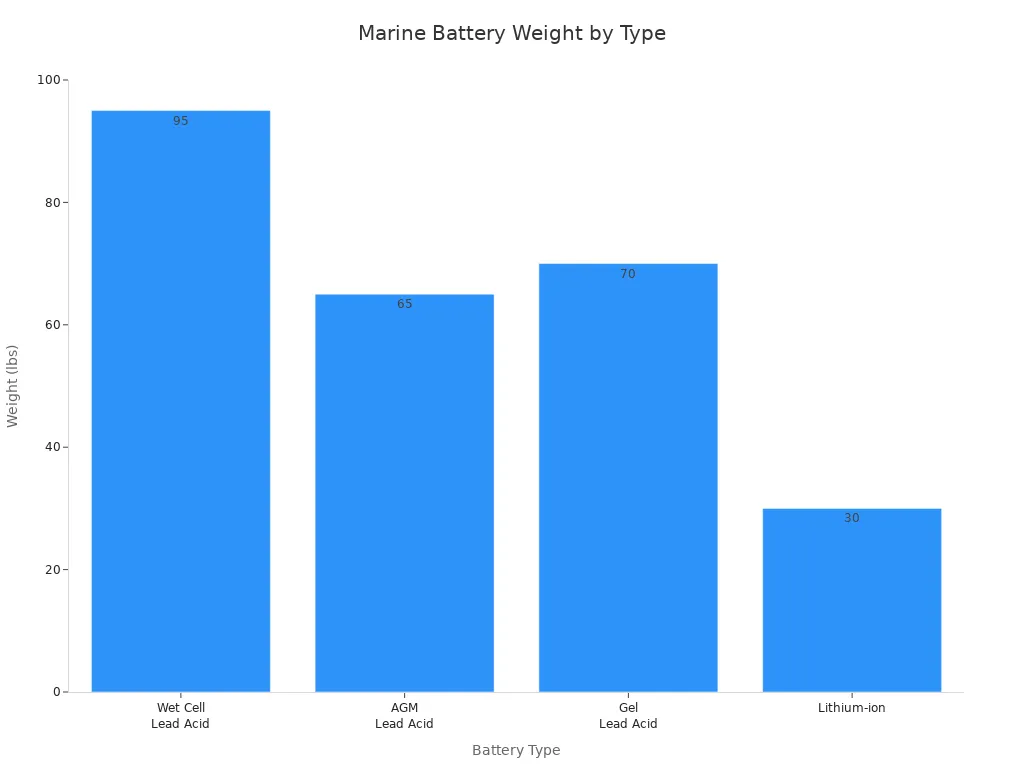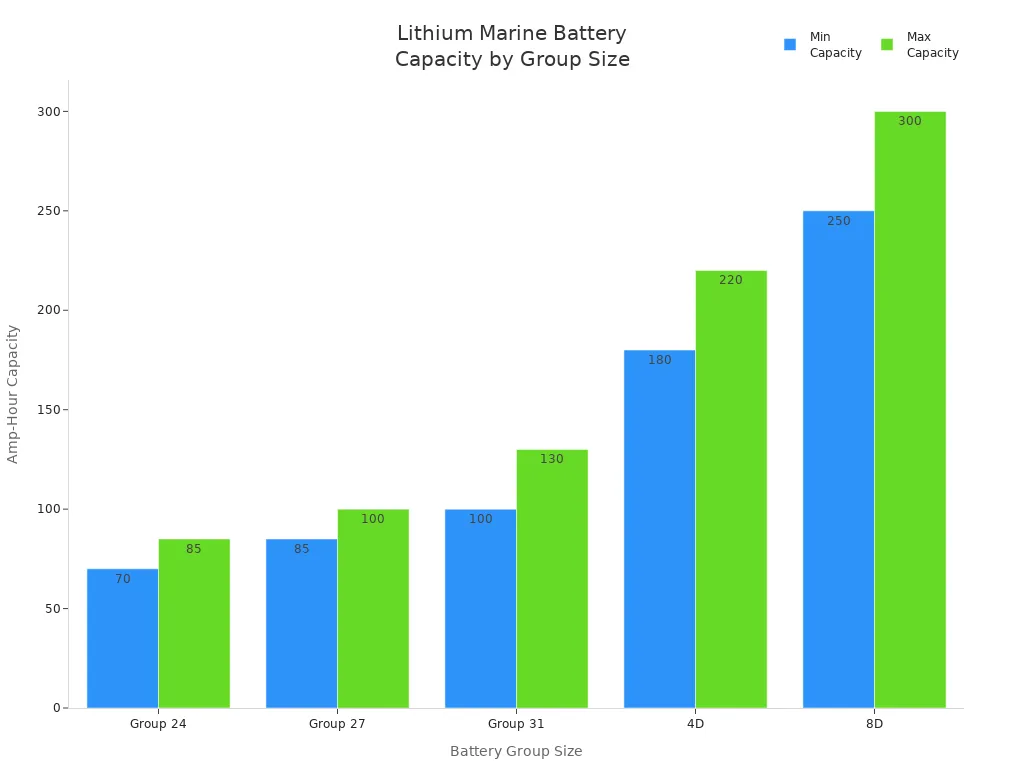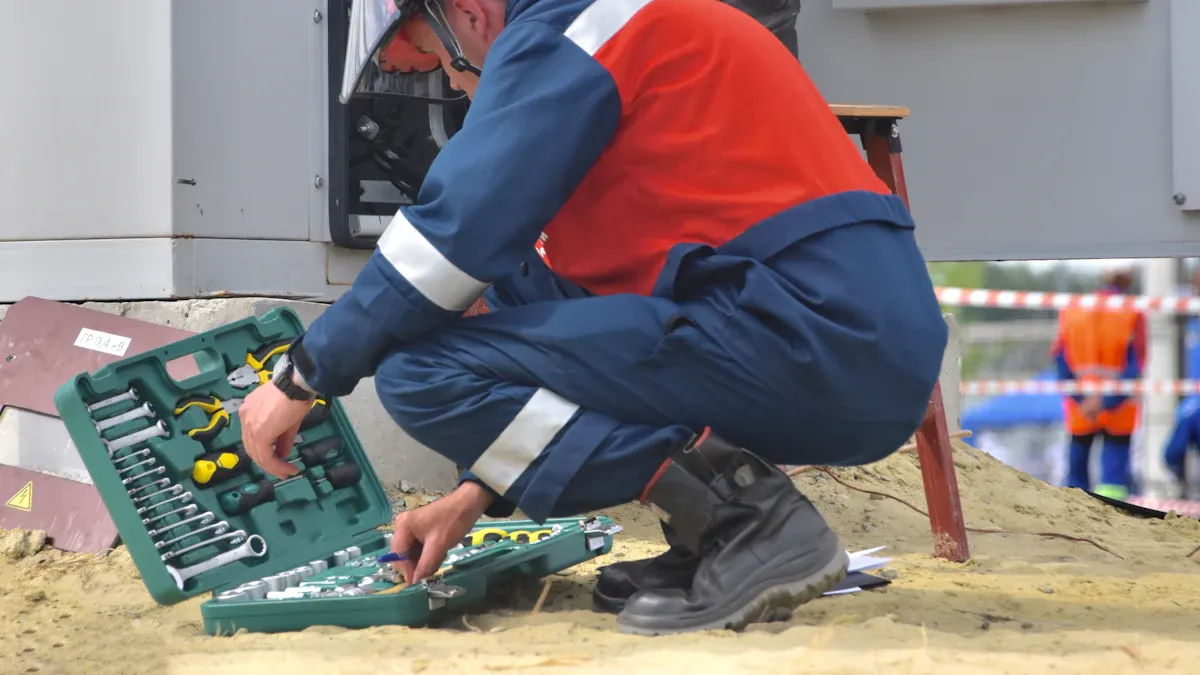
Lithium ion marine batteries set a higher standard for safety and performance on the water. You gain a battery with a lifespan up to ten times longer than traditional lead-acid, minimizing replacement costs and downtime. These batteries weigh less, reducing your vessel’s load and improving efficiency. You experience deeper discharge capability, with lithium ion marine batteries supporting up to 80% depth of discharge without damage. Maintenance requirements drop, and lithium ion marine battery cells maintain reliable voltage and power during every cycle. Consistent power delivery and reduced degradation under variable charging conditions help you operate marine systems with confidence.
Key Takeaways
Lithium ion marine batteries last much longer and weigh less than traditional lead-acid batteries, improving your boat’s efficiency and reducing replacement costs.
These batteries charge faster and allow deeper discharge, giving you more usable power and less downtime on the water.
Advanced safety features like Battery Management Systems protect against overcharging, overheating, and other risks, making lithium ion batteries safer for marine use.
Before switching to lithium ion batteries, check compatibility with your boat’s electrical system and choose the right size and charger for optimal performance.
Proper installation, regular monitoring, and safe storage extend battery life and keep your marine operations reliable and safe.
Part 1: What Are Lithium Ion Marine Batteries
1.1 Core Technology
You use lithium ion marine batteries because they rely on advanced lithium iron phosphate (LiFePO₄) chemistry. This chemistry gives each battery a high energy density, which means you get more power in a lighter, smaller package. Each lithium ion marine battery uses a battery management system (BMS) to monitor temperature, voltage, and current. The BMS protects your battery from overcharging, deep discharge, and overheating. This technology ensures optimal performance and safety for every cycle. You can expect a lithium ion marine battery to last over 3,000 full-depth cycles, which equals 8–10 years of use. In comparison, a typical deep cycle marine battery made with lead-acid chemistry often fails after 400–1,000 cycles.
1.2 Marine Applications
You find lithium ion marine batteries in a wide range of vessels and systems.
Electric boats, tenders, and yachts use these batteries for propulsion, giving you silent and zero-emission operation.
Hybrid vessels, such as tugboats and offshore supply ships, combine diesel engines with lithium ion marine battery banks to improve fuel efficiency and reduce emissions.
You rely on these batteries to power navigation and communication equipment, including GPS and radios.
Many vessels use lithium marine batteries to store energy from solar panels or wind turbines.
Auxiliary systems, such as lighting, refrigeration, and water pumps, depend on a deep cycle marine battery for reliable power.
In emergencies, a lithium ion marine battery serves as a backup power supply, keeping your critical systems running.
Tip: Choosing the right lithium ion marine battery ensures optimal performance for both propulsion and auxiliary systems.
1.3 Key Benefits
You gain several advantages when you choose lithium ion marine batteries for your fleet or vessel:
Longer Lifespan: Each lithium ion marine battery lasts up to ten times longer than a traditional deep cycle marine battery.
Lower Weight and Space Savings: These batteries weigh nearly 50% less than lead-acid batteries, freeing up valuable space on board.
Faster Charging: You can recharge a lithium ion marine battery two to five times faster than a lead-acid battery, reducing downtime.
Stable Voltage Output: Lithium marine batteries deliver consistent voltage, which is critical for sensitive marine electronics.
Superior Performance in Cold Weather: Many lithium ion marine batteries operate safely below freezing, thanks to built-in management systems.
You experience superior performance, reduced maintenance, and reliable power delivery with every lithium ion marine battery. These features make lithium ion marine batteries the preferred choice for modern marine operations.
Part 2: Lithium Ion Marine Batteries vs Lead-Acid

When you compare lithium ion marine batteries to lead-acid batteries, you see clear differences in performance, efficiency, and safety. These differences impact your vessel’s reliability, operational costs, and long-term value. Let’s break down the key areas where lithium ion marine battery technology delivers superior performance for marine professionals.
2.1 Weight and Size
You notice the lighter weight of lithium ion marine batteries as soon as you handle them. For the same capacity, lithium ion marine batteries weigh about one-third as much as lead-acid batteries. This weight reduction improves your vessel’s speed, fuel efficiency, and handling. You also save valuable space on board, making it easier to install or upgrade your battery system.
Battery Type | Marine Battery Weight (100Ah) |
|---|---|
Wet Cell Lead Acid | 95 lbs |
AGM Lead Acid | 65 lbs |
Gel Lead Acid | 70 lbs |
Lithium-ion | 30 lbs |

Switching from a 100Ah lead-acid battery to a lithium ion marine battery can reduce weight by 39-40 lbs per battery. This lighter weight means you can carry more equipment or supplies without exceeding your vessel’s limits.
2.2 Lifespan and Cost
Lithium ion marine batteries offer a much longer lifespan than lead-acid batteries. You can expect a lithium ion marine battery to last 2,000 to 5,000 charge cycles, while most lead-acid batteries last only 300 to 1,500 cycles. This longer lifespan means fewer replacements and less downtime for your operations.
Battery Type | Typical Lifespan (Charge Cycles) | Notes on Usage and Capacity |
|---|---|---|
Lithium-ion | 2,000–5,000 cycles | Three to five times longer than lead-acid batteries |
Lead-acid | 300–1,500 cycles | Shorter cycle life, more frequent replacements |
Although the initial purchase price for a lithium ion marine battery is higher, you save money over time. You avoid frequent replacements and reduce maintenance costs. Over a 10-year period, lithium ion marine batteries can lower your total cost of ownership by up to 75% compared to lead-acid batteries. You also spend less on labor, downtime, and energy because lithium batteries require no watering, cleaning, or ventilation.
Note: Lithium ion marine batteries use 30–50% less electricity during charging, which further reduces your operating costs.
2.3 Charging and Discharge
You benefit from much faster charging with lithium ion marine batteries. These batteries typically reach full charge in 3 to 4 hours, while lead-acid batteries can take 8 to 16 hours. This faster charging means less downtime and more time on the water.
Battery Type | Average Charging Time (hours) | Notes on Charging System |
|---|---|---|
Lithium ion phosphate (LiFePO4) | 3 to 4 | Fast charging, low internal resistance |
Sealed lead-acid | 8 to 16 | Slow charging, higher downtime |
Lithium ion marine batteries also allow deeper discharge. You can safely use up to 80–100% of their rated capacity without damaging the battery. In contrast, you should not discharge lead-acid batteries below 50%, or you risk shortening their lifespan. This deeper discharge capability gives you more usable energy per cycle and supports longer trips or heavier loads.
Battery Type | Depth of Discharge Capability | Impact on Lifespan and Usable Capacity |
|---|---|---|
Lithium-ion | 80–100% | Deep discharge without damage; longer cycle life |
Lead-acid | 30–50% | Discharge beyond 50% causes damage; shorter cycle life |
2.4 Cranking Power
When you need to start marine engines, cranking power matters. Lithium ion marine batteries deliver higher cranking amps than lead-acid batteries. Some lithium ion marine battery models provide up to 2,200 cranking amps in a compact, lightweight package. This high output ensures reliable engine starts, even in cold or demanding conditions. Advanced battery management systems in lithium batteries also enhance performance and reliability during engine starting.
Cranking batteries deliver high amperage in short bursts for engine starting.
Lithium ion marine batteries can provide up to 2,200 cranking amps, outperforming most lead-acid batteries.
You benefit from lighter weight, higher efficiency, and consistent power delivery.
2.5 Safety Features
Safety is a top priority for any marine operation. Lithium ion marine batteries include advanced safety features that most lead-acid batteries lack. Each lithium ion marine battery has a built-in Battery Management System (BMS) that protects against overcharging, overdischarge, overheating, and short circuits. Some models feature thermal regulation, low temperature charging cutoffs, and even built-in fire extinguishers for added protection.
The BMS monitors temperature, voltage, and current to prevent unsafe conditions.
Low voltage protection and overcurrent protection help avoid battery damage.
Thermal regulation ensures safe operation in extreme temperatures.
Jump-start capability allows recovery from deep discharge.
Lead-acid batteries, on the other hand, require careful maintenance and proper ventilation to prevent hydrogen gas buildup during charging. This gas can pose an explosion risk in confined spaces. While lead-acid batteries do not face thermal runaway, they lack the integrated protections found in lithium marine batteries.
Tip: Always install lithium ion marine batteries according to manufacturer guidelines to maximize safety and optimal performance.
You gain superior performance, longer lifespan, lighter weight, and enhanced safety when you choose lithium ion marine batteries over traditional lead-acid batteries. These advantages translate into lower costs, less downtime, and more reliable marine operations.
Part 3: Considerations Before Choosing Lithium Ion Marine Battery
When you evaluate considerations before choosing lithium ion marine battery solutions for your fleet or marine operations, you must weigh several critical factors. These factors help you maximize safety, performance, and long-term value.
3.1 Upfront Cost
You notice that lithium ion marine batteries cost more upfront than lead-acid batteries with similar capacity. The higher initial investment reflects advanced technology, longer lifespan, and reduced maintenance. Although lead-acid batteries offer a lower purchase price, you spend more over time due to frequent replacements and ongoing maintenance. Lithium ion marine battery packs deliver better long-term value, especially for commercial vessels and industrial marine applications. You reduce downtime and labor costs, which improves operational efficiency.
Tip: Consider total cost of ownership, not just the initial price, when selecting a lithium ion marine battery for your marine operations.
3.2 Compatibility
You must check compatibility between your lithium ion marine battery and existing marine electrical systems. Older boats often face challenges when upgrading to lithium technology. The table below highlights common compatibility issues and recommended solutions:
Compatibility Issue | Explanation | Impact on Older Boats | Recommended Solution/Consideration |
|---|---|---|---|
Voltage Compatibility | Lithium (LiFePO₄) batteries have a higher voltage plateau (13.2–13.6V) than lead-acid (12.6V nominal). | Older motors/electronics calibrated for 12.6V may overheat or fail early. | Use voltage regulators or confirm motor compatibility before installation. |
Charger Pairing | Lead-acid chargers do not support lithium’s CC/CV charging profile with proper cutoff thresholds. | Improper charging can damage lithium batteries. | Use chargers designed for lithium batteries with appropriate profiles. |
Cold Weather Charging | Lithium batteries cannot safely charge below 32°F (0°C) without thermal protection. | Older boats may lack thermal protection, risking battery damage. | Use lithium batteries with internal heaters or insulation for cold climates. |
Installation Environment | Marine conditions require moisture, vibration, and corrosion resistance. | Older boats may not have suitable enclosures or terminals. | Use IP65/IP67 rated enclosures, vibration-isolated mounts, corrosion-resistant terminals, and follow ABYC E-13 standards. |
Battery Management System | Lithium batteries require a smart BMS to manage voltage, current, and temperature. | Lack of BMS can lead to overcharging, short circuits, or thermal events. | Ensure lithium batteries include a smart BMS for safe operation. |
To ensure proper integration, you should:
Select a charging system with a profile tailored for lithium ion marine battery technology.
Upgrade wiring, fuses, and circuit breakers to handle higher discharge rates.
Integrate battery monitoring systems for real-time performance tracking.
Follow ABYC E-13 installation requirements for safety and reliability.
3.3 Sizing and Power
You must size your lithium ion marine battery correctly to meet your vessel’s power needs. Start by listing all electrical components and calculating total energy use per hour. Account for power reserves to handle unexpected surges or engine starting. Measure available space to ensure the battery fits safely. Consider your vessel type, trip duration, and frequency of use. The table below helps you match battery group size to typical amp-hour capacity and vessel type:
Battery Group Size | Typical Amp-Hour Capacity | Suitable Vessel Type / Usage |
|---|---|---|
Group 24 | 70–85 Ah | Small boats with modest power needs (cabin lights, fish finder) |
Group 27 | 85–100 Ah | Boats with trolling motors and additional onboard systems |
Group 31 | 100–130 Ah | Boats requiring serious power for extended trips |
4D | 180–220 Ah | Larger vessels or energy-intensive setups (windlasses, refrigerators) |
8D | 250–300 Ah | Large vessels with high power demands |

Note: Lithium ion marine batteries are ideal for vessels that require high power-to-weight ratios or have limited space. You benefit from lightweight packs, high energy density, and long cycle life.
3.4 Battery Management System
A Battery Management System (BMS) is essential for safe and efficient operation of any lithium ion marine battery. The BMS monitors voltage, current, and temperature to keep the battery within safe operating limits. It prevents overcharging, over-discharging, thermal runaway, and short circuits. The BMS balances charge across individual cells, maximizing usable capacity and extending lifespan. You receive real-time data on state of charge and state of health, which helps you avoid unexpected power loss and schedule maintenance.
Key BMS features to look for include:
Short-circuit and overcurrent protection for fluctuating power demands.
Accurate state of charge and state of health estimation.
Communication capabilities for remote monitoring and diagnostics.
Cell voltage and temperature monitoring with alarms and automatic protective actions.
Reliable power interruption methods, such as MOSFET-based or contactor-based systems.
Tip: Always choose lithium ion marine batteries with a robust, smart BMS to ensure safety and reliability in demanding marine environments.
3.5 Environmental Factors
You must consider environmental factors when selecting a lithium ion marine battery for marine use. Batteries perform best within an optimal temperature range of 20°C to 30°C. Exposure to temperatures above 35°C accelerates degradation, while low temperatures increase lithium plating and capacity loss. High humidity and salt spray can cause corrosion and water intrusion, which shortens battery lifespan. Marine lithium ion batteries use waterproof designs and corrosion-resistant materials, but you should still store batteries in cool, dry, well-ventilated areas.
Avoid overcharging, deep discharging, and fast charging to reduce thermal stress.
Store batteries at 40%-60% charge in controlled environments.
Use enclosures rated for moisture and vibration resistance.
Select batteries that meet ABYC E-13, ABS, UL, IEC 62133, ISO 9001, ISO 14001, TÜV Rheinland, and UN/DOT 38.3 standards for marine safety and environmental compliance.
Callout: Proper temperature control, humidity management, and certified battery packs are critical for maintaining performance and longevity in marine settings.
You improve safety, reliability, and operational efficiency when you address these considerations before choosing lithium ion marine battery solutions for your marine fleet or industrial applications.
Part 4: Safety and Care for Lithium Marine Batteries

4.1 Installation
You must follow strict safety measures and caring tips when installing lithium marine batteries. Start by measuring the battery storage space to ensure a proper fit. Select a battery with enough capacity for your marine power needs. Confirm voltage compatibility and wiring with your vessel’s electrical system before installation. Always use approved equipment, including chargers managed by a Battery Management System (BMS). Secure the battery firmly to the boat’s structure to prevent movement or vibration, which can damage internal components. Handle batteries with care, using gloves and eye protection to avoid injury. Inspect the battery for any signs of damage, such as bulges or leaks, before use. Keep batteries away from children and never puncture or disassemble them.
4.2 Charging and Monitoring
Charging lithium ion marine batteries requires attention to detail. Use a charger designed for lithium batteries, as it provides the correct charge profile and built-in safety features. Limit charging speed to the manufacturer’s recommended rate to protect battery health. Monitor the battery and its surroundings during charging. If you notice unusual heat, odors, or noises, stop charging immediately. The BMS helps manage charge and discharge, preventing overcharging or deep discharge. Maintain temperature control by operating batteries within the recommended range. These safety measures and caring tips help you achieve safer operation and extend battery life.
4.3 Emergency Procedures
If a lithium ion marine battery fails or catches fire, act quickly. Establish a safety zone around the incident to protect yourself and others. Use cooling techniques, such as water or fire blankets, to manage heat and reduce the risk of thermal runaway. Know your vessel’s emergency shutdown procedures to isolate the battery and cut off power. Always wear personal protective equipment to avoid chemical exposure. After extinguishing a fire, monitor the battery for signs of reignition. Regular training and knowledge of your battery system improve your response to emergencies.
4.4 Storage Tips
Proper storage is essential for lithium marine batteries. Before storage, charge the battery to about 50%. Store batteries in a cool, dry place between 41°F and 68°F, away from direct sunlight and moisture. Avoid extreme temperatures and high humidity, as these conditions can cause chemical degradation. Periodically check the battery’s state of charge. If it drops below 40-50%, recharge to about 50%. The BMS helps monitor and manage the battery during storage, preventing overcharge or deep discharge. These safety measures and caring tips ensure your lithium ion marine battery remains reliable and ready for use.
Tip: Following these safety measures and caring tips protects your investment and supports long-term marine performance.
You gain major safety and performance improvements when you choose lithium ion marine batteries for your fleet. These batteries deliver longer cycle life, faster charging, and stable voltage output. You reduce downtime and lower maintenance costs with every battery upgrade. Proper selection and installation of batteries protect your investment and ensure reliable operation. You support efficient marine systems by following best practices for battery care.
Consider lithium ion marine batteries to maximize value and safety for your marine business.
FAQ
What is the recommended charging profile for lithium iron phosphate (LiFePO₄) marine batteries?
You should use a charger with a constant current/constant voltage (CC/CV) profile. Set the voltage to 14.2–14.6V per 12V battery pack. This ensures safe, efficient charging and extends battery life.
How does a Battery Management System (BMS) improve safety in marine lithium battery packs?
A BMS monitors voltage, current, and temperature. It prevents overcharging, deep discharge, and overheating. You gain real-time protection and alerts, which reduce the risk of battery failure or fire on your vessel.
Can you replace lead-acid batteries with lithium ion marine batteries without modifying your boat?
You often need to upgrade chargers, wiring, and sometimes enclosures. Lithium ion marine batteries require compatible charging systems and proper installation. Always check your vessel’s electrical system before making the switch.
What maintenance do lithium ion marine batteries require?
You do not need to water or clean lithium ion marine batteries. Regularly inspect connections and monitor battery status using the BMS. Keep batteries dry and secure. Schedule periodic checks for optimal performance.
Are lithium ion marine batteries safe for use in harsh marine environments?
Yes. Lithium ion marine batteries with IP65 or higher ratings resist moisture, vibration, and corrosion. You should install batteries in protected enclosures and follow manufacturer guidelines for maximum safety and reliability.




